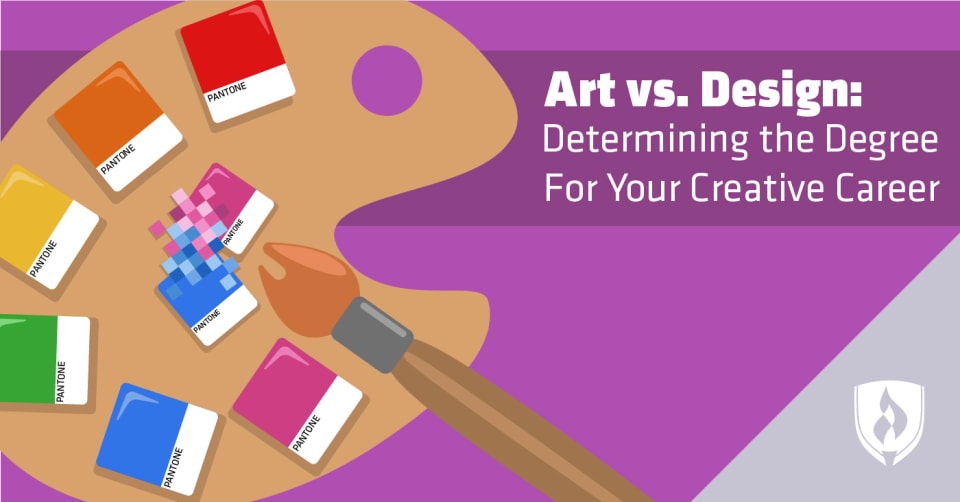
You’re a creative soul and live by your convictions. To sacrifice your creativity is out of the question when it comes to potential careers. That’s why you’ve narrowed down your choices to a select few in your search: art and design. But which degree should you choose? And what exactly is the difference between art versus design?
You’ve come to the right place to get your questions answered. We spoke with Dale Addy, partner of DNA Creative Marketing and seasoned expert of the art and design fields to help. Keep reading to learn more about these two fields and degree options to see which one is the right fit for you.
Art vs. design: What’s the difference?
The lines can blur between art and design. They’re both visual and are based off aesthetic principles. They’re both highly creative and take much skill and talent. They can be beautiful, interesting, unsettling and moving. But art and design differ greatly too.
Design solves problems, while art raises questions. Design motivates, art inspires. Design is understood, art is interpreted. Design typically starts with a message, idea or objective. Art starts with a blank canvas. Design should leave audiences with one clear action, sentiment or idea. Art should leave audiences with a multitude of impressions. Design joins function with aesthetics, while art uses aesthetics and self-expression.
“Design is all about taking a business need and finding a solution in a creative, compelling way,” says Addy. “Art is about expressing an inner feeling and showing that to the world.”
Art and design also diverge based on where they are found and how they come to be. Graphic design is executed on a broad spectrum—billboards, logos, magazine layouts, websites and so much more. Art, too, is expressed through many mediums, such as sculpture, video, drawing, painting, photography and other forms.
Art vs. design: What do you learn in school?
The skills and types of things you’ll learn in school differ between art and design degrees. If you’re majoring in Art, you can anticipate to spend much time in the studio getting your hands dirty while trying different mediums and building your portfolio. You will probably focus your studies on a specific concentration, such as painting, photography, ceramics, sculpture or other mediums.
“Art majors will work to develop an individual style and voice that is uniquely their own, while design majors are usually asked to explore different styles and voices in order to enhance the concepts they develop,” says Addy. “Design majors focus more on ‘design thinking,’ which works to find multiple solutions for the same problem.”
If you’re majoring in Graphic Design, you’ll learn how to use technologies of the industry and develop in-demand skills, such as typography, interactive media, user experience (UX) design and video editing.
As for level of education, about 62 percent of graphic designers have a Bachelor’s degree, while 23 percent have an Associate degree or post-secondary Certificate. When it comes to artists, an estimated 22 percent have a Bachelor’s degree.
Art vs. design: What careers you can pursue?
These two majors also offer different career paths. If you study graphic design, many of the options available to you will be centered closely on the field and skills you mastered while in school. You could become a graphic designer, an animator, a web designer or another role related to design.
If you study art, you can go on to live off your artistic pursuits. Some Art majors go the academic route and work for colleges and universities. Some go into curator work in art museums. Some become art critics or art instructors. Career options vary for Art majors.
Art vs. design: Finding success in your field
If you go into a certain field, you do it because it interests you. But there’s also a level of practicality to also consider. After you graduate, you’re going to want to find a job and put food on the table as well. How can you do what you love but also be successful?
“While both fields are competitive, fine art is like trying to make it as a rock star. We all dream of it, but few actually obtain it. The ‘starving artist’ idea isn’t too far off base. That doesn’t mean you shouldn’t try, though. It just means you have to be all-in to succeed,” says Addy.
“Design is similar, in that in order to be successful, you have to live, eat and breathe design. The difference is the luck factor. In graphic design, you can make your own luck in a way through work and dedication to honing your craft. In fine art, it’s really about the stars aligning and finding a niche for your particular style of art.”
In other words, go after what you love with everything you’ve got—talent, determination and a lot of hard work.
Art vs. design: How will you choose?
At the end of the day, only you know which degree will be right for you, your career and your goals.
“The best advice I can give to a student trying to decide if they want to go the art or design route is to ask themselves how much of a risk are they willing to take,” says Addy.
“Design can be a risk simply because it’s all about your talent level. In the design field, you start out working at an agency or design firm along with other creative people. You have to prove your creative worth, and it’s very competitive. But hard work goes a long, long way.”
“On the fine art side of things, it’s about talent, hard work and also a whole lot of luck. Your career route starts and ends with you alone. That means you really don’t have an opportunity to learn from more seasoned veterans. You have to learn everything all by yourselves, which can be scary and expensive and take a long time before any real success is achieved.”
Create your career path
Both art and design have a lot to offer prospective creative professionals like you. They both play on your talents and skills. They both need an eye for composition. They both have their own sets of risk and reward. At least you know there’s options, so you don’t have to trade off your creativity for a career.
If you’re leaning toward graphic design, check out our article, 7 Signs You Might Make a Good Graphic Designer to learn more about whether you’re cut out for this profession. If you’re still not so sure, check out our article, 9 Types of Design Jobs for Creative People to learn more about all the options available to you.
RELATED ARTICLES:




